|
Winmate Rugged Tablet PC I880
Intel Core 2 Duo version of Winmate's rugged tablet computer platform for tough jobs
(by Conrad H. Blickenstorfer -- photography by Carol Cotton -- view PDF version)
Ever since its founding in 1994, Winmate of Taiwan has been specializing in industrial display technologies and solutions. The company has also branched out into Panel PCs, digital signage, marine grade displays and computers and, most recently, rugged Mobile PCs, panels, embedded automation controllers, and rugged Tablet PCs such as the I880 reviewed in this article. Winmate does not yet have the name recognition of some of the major players in the rugged field, but that is often the case with Taiwanese OEMs who either make products for name brands or work through resellers, system integrators and distributors.

The I880 is a member of Winmate's compact, rugged Tablet PC slate family that comes in a variety of configurations. This review covers the R12I88M-RTM7 model that comes with a 12.1-inch XGA (1024 x 768 pixel) display with a 4-wire resistive touchscreen and a strong 450-nit backlight (commercial notebooks usually have less than 200 nits, and a 200 nit version is also available). Onboard connectivity consists of three USB 2.0 ports, a RS232 connector, RH45 LAN, microphone and headphone jacks, and a docking connector.
The machine measures 12.6 x 9.5 inches and weighs just under six pounds as tested. Our review unit was powered by an Ultra Low Voltage 1.06GHz Intel Core 2 Duo processor that was designed from the start for the lowest possible power consumption, and uses the complementary Intel 945 GME + ICH7. The I880 comes standard with 512MB of DDR2 533 memory in a SO-DIMM, upgradeable to 2GB. Storage is either via an 80GB 2.5-inch hard disk or an industrial Compact Flash module. The machine has integrated 802.11b/g WiFi and Bluetooth. WWAN (GPRS/ GSM/ CDMA/ UMTS/ EDGE) and GPS are available via PCI Express card extensions.
This is a mid-range tablet computer designed for use in applications where workers carry the machine around on the job and use it while standing up, which makes a notebook impractical. Its 12.1-inch XGA display is large for a tablet, and its 64-bit Core 2 Duo processor is inherently more complex and powerful than lower end chips from Intel or other chip foundries. The I880 is also designed so it can survive being dropped, rained on, or used in extreme temperatures or other adverse environmental conditions. Winmate targets this machine to applications in field service, law enforcement, fire/emergency, transportation and distribution, construction, utility & energy, warehousing, patient information, and retail.
Design and construction
Like all of Winmate's rugged tablets, the I880's design is very straightforward. There is no fan, and that always simplifies things. The housing consists of two halves, an ABS plastic top and an aluminum-magnesium bottom, with the heavy bottom piece providing complete rigidity. The plastic top probably saves some weight, which allows Winmate to offer a big 12.1-inch screen but still come in under six pounds in a very rugged machine.
The two halves of the computer are held together by just four Philips head screws, one at each corner. A pressure gasket around the entire perimeter provides a seal good enough to facilitate the unit's IP54 rating. There are a number of openings cut into the sides and the back. Those are sealed with thick, soft rubber plugs that are attached to the inside of the machine with Philips screws. This makes them very easy to replace in case that they ever break. The flipside is that those rubber plugs form the sole barrier between outside and inside, which means they must be firmly in place in order to protect the innards of the I880.
Below you can see all four side views of the Winmate I880. Note that the protective rubber plugs were left in place for product photography.
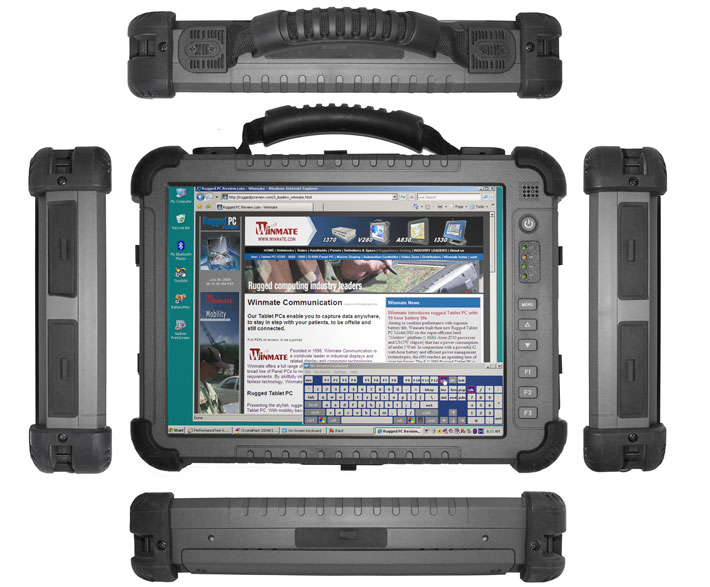
Winmate designed the I880 with a minimum of hardware controls and buttons so as to make it as simple as possible to operate. To the right of the display is the power button and below that four small indicator lights that show:
- Power mode (green light when the unit is on)
- Battery status (green for fully charged, red blinking for low battery, and orange for being charged)
- Hard disk activity, and
- WiFi activity
Beneath the indicator lights is a menu button with up and down keys below it. When pushed, the menu button cycles through:
- Brightness (adjustable in eight steps)
- Volume (adjustable in eight steps)
- Remaining battery life in percent, and
- WiFi/Bluetooth (WiFi on/off, Bluetooth on/off, both on/off)
- Version info for the HotTAB Utility, BIOS and EC
Brightness doesn't go down as low as on the I980 units that use an LED backlight that can be dimmed to as low as 5 nits to save power and reducing unwanted attention. As listed, the radios can either both be off, both on, or either WiFi or Bluetooth on. The up and down buttons are used both to select and adjust. Pushing the menu button for four seconds locks and unlocks the machine.
There are also three programmable function buttons labeled F1, F2 and F3. Each responds to either a short or a long push so that you can assign a total of six functions. Programming is via the included HotTab utility. You can either select from the default functions and applications and assign them to the keys, or browse for any other function or application. For example, we assigned the onscreen keyboard to F1, the calculator to F2, and My Documents to F3. In the advanced HotTAB utility function you can also assign "Virtual Resolution" as a programmable button function.
The HotTAB utility also offers a variety of different battery warnings that alert to a) low battery status without warm-swap, b) low battery with functional warm-swap backup, and c) low battery status without enough backup battery power for a warm-swap.

Compared to earlier versions of the HotTAB utility, Winmate added four additional functions that can be assigned to a short push of the F1 button. They are:
- Virtual Mouse
- Screen Rotation
- Onscreen Keyboard
- Handwriting Verification (optional with the Penpower utility)
Another addition is an "advanced" function section where you can program the I880 for one-touch switching between power modes (extreme performance, high performance, office/document, and power saving). Switching power modes on the fly without having to dig into complex power savings control panels can significantly extend battery life in the field.

Optionally available are a handstrap mounted to the back of the machine via four screws; a carry handle; a carry belt; a desktop dock/stand with battery charger; and a car power adapter.
The unit has the following ports:
- Lower right: USB and 9-pin RS232 serial
- Upper right: VGA video
- Lower left: Power and 2 USB
- Upper left: RJ45 LAN, microphone and headphone jacks
- Top: PCI Express 34 card
- Bottom: Docking connector
Additional ports are available via an optional expansion dock. It offers four USB 2.0 ports, VGA, RJ-45 LAN, and can also charge a second battery.
A look inside
Just like you can tell a lot about a car by looking underneath its hood, you can tell a lot about a rugged system's suitability for use in demanding environmental applications. Some mobile computers look tough and rugged outside but disappointingly unfinished and disorganized inside. That's why at RuggedPCReview.com we take a look inside the computers we test whenever we can. It's always good to take a look at the board engineers' work and how well a system is manufactured and finished.
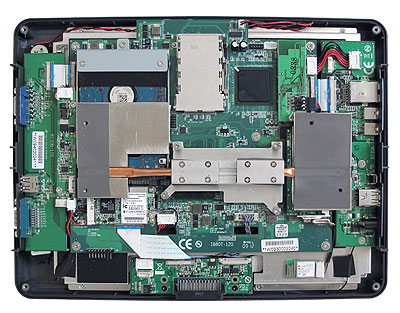 The inside of the unit (see picture to the right) shows the I880's rectangular motherboard and a variety of peripheral boards surrounding it. In essence, Winmate's practice of separating the motherboard from the interface boards allows the company to quickly and easily customize a machine for client applications without having to redesign the motherboard itself. The inside of the unit (see picture to the right) shows the I880's rectangular motherboard and a variety of peripheral boards surrounding it. In essence, Winmate's practice of separating the motherboard from the interface boards allows the company to quickly and easily customize a machine for client applications without having to redesign the motherboard itself.
Despite its fairly powerful Intel Core 2 Duo processor, like other models in Winmate's extensive lineup of rugged Tablet PCs, the I880 does not need a fan. This is accomplished via clever thermal engineering. There is an elaborate heatsink/heatpipe system inside the machine that draws heat away from hot-running components and dissipates it first through internal heatsinks and then through the entire bottom half of the computer. The aluminum-magnesium alloy bottom has integrated heat dissipation fins, and weighs 1.65 pounds. That certainly makes a good heatsink.
Beneath the bottom left of the heatsink there is a QCOM 802.11b/g Wireless PCI Express Mini Card with USB Interface. Top center you can see the Express Card 34 slot, and underneath the sink on the right side is the single SODIMM slot. What you can't see in the small picture is that anything that could come loose is held in place with a drop or two of silicon glue. That includes almost all connectors and even the RAM module.
The disk is a 2.5-inch Fujitsu MHZ2080BH with a capacity of 80GB. It rotates at 5,400rpm and has a 3GB/second SATA interface. The disk uses perpendicular magnetic recording (PMR) technology and was designed to provide exceptionally high quality, reliability and performance with minimal heat and acoustics for notebooks and consumer electronics applications requiring high speed and high capacity. It is mounted in a subframe that is packed with what looks like neoprene. There is also a neoprene sheet between the motherboard and the disk assembly. The disk subframe is held in place with a screw. There is no way that it can shake itself loose.
All interface openings have tight-fitting rubber plugs with lips and small pull-handles. The lips make sure that the plug sits exactly right, and the lips are there to pull the plug out when you need access to a port. Each plug is hinged to the computer via two rubber straps. Those are anchored inside the computer with Philips screws. This way, the plugs can easily be replaced should they break or get damaged.
The seal between the two halves is a pressure seal where the metal half pushes against a rubber gasket with a square profile that is glued onto an inside ledge of the plastic front. Note that this is not an uninterrupted O-ring type of seal. Likewise, the jacks mounted on the peripheral daughterboards are not sealed. Protection is provided by the rubber plugs.
Display
Winmate, very much a technology company, has given considerable thought to the topic of optimal display viewability under all sorts of lighting conditions. A whole section of their website is dedicated to "Optimized Visibility" where they discuss in great detail optical bonding, sunlight readability, hyper dimming, AR/AG glass, and light sensors. Since Winmate offers numerous display sizes and technologies I am not sure which of those technologies were included in our review unit's display. The picture below, taken outdoors on a sunny morning, shows a comparison between the I880 and a standard consumer market netbook. As you can see, the I880 has very effective anti-glare properties and also enough anti-reflective treatment to keep the image visible in sunlight.
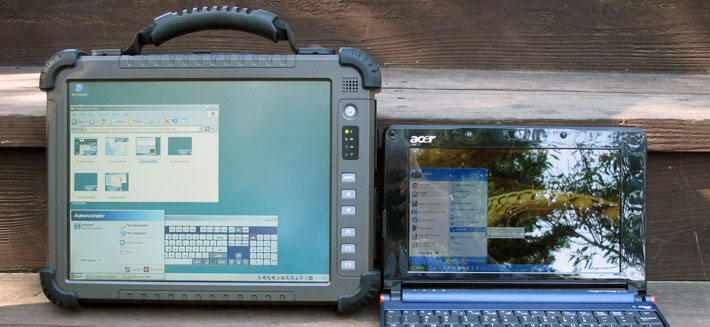
The one improvement we'd like to see is a larger vertical viewing angle. As is, you get quite a bit of color shift and chromatic aberrations if you rotate the tablet around its horizontal axis. Else, the large, bright and very responsive XGA touchscreen display of the I880 is doubtlessly one of the unit's most attractive features.
Operating System
As is the case with most of Winmate's rugged tablets, the key to understanding machine likes these and what they are capable of is in understanding the difference between a general purpose OS and an embedded OS.
A general purpose OS, like Windows XP Professional, Vista, or Windows 7 is just that, general purpose. You can do anything you want with it, and run anything you want on it. With that in mind, Microsoft equipped its full-function operating systems with all the drivers and software and utilities anyone could possibly need. The result is very large operating systems with dozens or hundreds of processes and services running at all times, all consuming memory and power. That's why they require the newest, fastest, and most powerful processors and as much memory as possible.
 Embedded operating systems are completely different. The idea behind them is to include only the software functionality the system actually needs to perform a certain task and nothing more. This greatly reduces the space and resource requirements of the OS and means it can do its job without a hot-running, battery-draining processor and lots of memory. Windows XP Embedded therefore remains an ideal OS for commercial and industrial devices that do not need all of a full-featured consumer or business OS, yet can still run thousands of existing Windows applications. An embedded OS can be as small as 40MB and, according to Microsoft, it's even possible to cut it all down to around 8MB with a bootable kernel. Embedded operating systems are completely different. The idea behind them is to include only the software functionality the system actually needs to perform a certain task and nothing more. This greatly reduces the space and resource requirements of the OS and means it can do its job without a hot-running, battery-draining processor and lots of memory. Windows XP Embedded therefore remains an ideal OS for commercial and industrial devices that do not need all of a full-featured consumer or business OS, yet can still run thousands of existing Windows applications. An embedded OS can be as small as 40MB and, according to Microsoft, it's even possible to cut it all down to around 8MB with a bootable kernel.
Unlike Windows 7, Vista or XP Pro, XP Embedded is not a shrinkwrapped one-size-fits all OS. Systems integrators will determine what a machine should be able to do and then include just the software blocks and components they need (hence the term "componentized" operating system). There are over 10,000 components to pick and choose from, and it's easy for experienced integrators to create lean, nimble embedded OS platforms that can still do sophisticated high level functions like advanced multimedia, browsing, communications or whatever a task requires. What it amounts to is that an XP Embedded build provides all the power of the Windows XP engine, but without any unneeded overhead.
This means that one cannot easily predict performance of an embedded systems machine by simply looking at its processor and processor speed, and even benchmarks do not necessarily tell the true story. That's because benchmarks measure raw power, but not how efficiently that power is being used. In the case of the Winmate I880, one might erroneously assume that a machine with a 1.06GHz processor could not possibly be very quick. In fact, even with just 512MB of RAM, the I880 is very responsive and feels much quicker than many Vista machines using more powerful hardware. It also boots very quickly, going from power-on to seeing the Windows desktop in about 30 seconds.
Where does the I880 fit in in terms of performance?
While it is not unusual for computer companies to offer processor options in their products, few offer as many as Winmate. As of mid-2009, it is possible to get Winmate's rugged tablet with no fewer than five different processor architectures, four from Intel and one from VIA. The Intel choices are the two Atom processors (N270 and Z530, both running at 1.6GHz), an older Celeron-M, and an ultra low voltage 1.06GHz Core 2 Duo U7500, whereas VIA-powered systems use the 1.2GHz C7-M. While the VIA and the two Atom chips are inexpensive low-end processors that provide "targeted" performance (i.e., just enough), the Core 2 Duo is a highly complex 64-bit dual processor design with six times as many transistors as the Atom chips. The U7500 also costs a lot more than the other chips, so the choice of a Core 2 Duo version will usually be driven by programming and performance requirements.
The table below shows some of the specs and features of four of the processor families used by Winmate:
|
PROCESSOR STATS
|
Winmate I880
|
Winmate I980
|
Winmate IA80
|
Winmate V280
|
|
CPU
|
Intel Core 2 Duo U7500
|
Intel Atom Z530P
|
Intel Atom N270
|
VIA C7M
|
|
CPU Speed
|
1.06GHz
|
1.6GHz
|
1.6GHz
|
1.2GHz
|
|
CPU Thermal Design Power
|
10.0 watts
|
2.3 watts
|
2.5 watts
|
5.0 watts
|
|
# of Cores
|
2
|
1
|
1
|
1
|
|
L2 Cache
|
2048KB
|
512KB
|
512KB
|
128KB
|
|
FSB speed
|
533MHz
|
533MHz
|
533MHz
|
up to 800MHz
|
|
Instruction Set
|
64-bit
|
32-bit
|
32-bit
|
32-bit
|
|
Lithography
|
65nm
|
45nm
|
45nm
|
90nm
|
|
Transistors
|
291 million
|
47 million
|
47 million
|
TBD
|
|
Intel Virtualization
|
Yes
|
No
|
Yes
|
NA
|
|
Enhanced Halt State
|
Yes
|
No
|
Yes
|
NA
|
|
Intel Hyper Threading
|
No
|
Yes
|
Yes
|
NA
|
|
Intel Demand Based Switching
|
No
|
No
|
Yes
|
NA
|
|
Intel 64
|
Yes
|
No
|
No
|
NA
|
To test the performance of the Winmate I880 we installed Passmark Software's PerformanceTest 6.1, a benchmark suite that runs about 30 tests covering CPU, 2D graphics, 3D graphics, memory, and disk and then computes scores for each category and an overall PassMark score. For comparison, the table below also shows the benchmark numbers of Winmate tablets that use the other three processors Winmate offers. The results were as follows:
|
RELATIVE PERFORMANCE
|
Winmate I880
|
Winmate I980
|
Winmate IA80
|
Winmate V280
|
|
CPU
|
Intel Core 2 Duo U7500
|
Intel Atom Z530P
|
Intel Atom N270
|
VIA C7M
|
|
CPU Speed
|
1.06GHz
|
1.6GHz
|
1.6GHz
|
1.2GHz
|
|
CPU Thermal Design Power
|
10.0 watts
|
2.3 watts
|
2.5 watts
|
5.0 watts
|
|
CPU Mark
|
338.4
|
328.7
|
162.7
|
137.3
|
|
2D Graphics Mark
|
297.2
|
187.9
|
212.3
|
174.0
|
|
Memory Mark
|
236.5
|
209.1
|
224.0
|
124.1
|
|
Disk Mark
|
390.3
|
151.1
|
382.5
|
305.1
|
|
3D Graphics Mark
|
91.2
|
38.5
|
81.3
|
38.8
|
|
Overall PassMark
|
264.6
|
194.1
|
200.2
|
149.4
|
|
Observed Power Draw
|
13.60 watts
|
7.24 watts
|
12.80 watts
|
10.50 watts
|
|
Projected Battery Life
|
3.90 hours
|
7.35 hours
|
4.16 hours
|
5.05 hours
|
As is often the case with benchmarks, the results are somewhat inconclusive and primarily show that it is very difficult to compare different processor architectures. Even the two different Atom families deliver oddly inconsistent benchmark results. You could probably argue that benchmarks are best used to compare only among the exact same CPU architectures. That said, in our hands-on experience with all four machines, observed overall performance pretty much corresponds to the overall benchmark bottomlines. However, any of the systems may be the best choice for a particular set of specific application requirements.
Power
Thanks to a remarkably good effort by Intel to highlight the power efficiency of its Atom processors, the notion has taken hold that its use is almost mandatory for modern mobile systems with long battery life. That is true to some extent, but in our experience, systems with low-power versions of Intel's Core processors can be almost as frugal while delivering more, and more versatile, performance. We ran PassMark's BatteryMon power benchmark to see how well the Winmate I880 handles precious battery power.
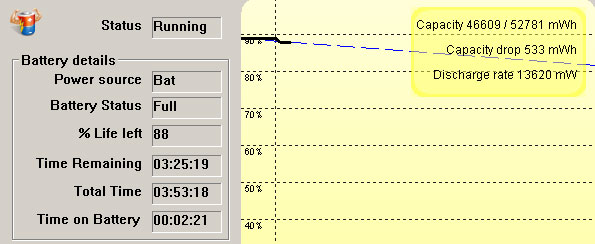 Battery life, of course, depends on both power draw and the size of the battery. The power pack in our review Winmate I880 was a 11.1 Volt/4,800 mAH (53.3 watt-hour) Lithium-Ion battery that is part of the design and fits flush into the backside of the housing. It is held in place by four big Philips screws, which means that this battery will never accidentally come loose. The connector contact block at the bottom of the battery has a rubber pressure seal that pushes against the inside of the battery compartment floor and thus creates a watertight seal. Do make sure the battery is very firmly secured as there is no further protection against water. Battery life, of course, depends on both power draw and the size of the battery. The power pack in our review Winmate I880 was a 11.1 Volt/4,800 mAH (53.3 watt-hour) Lithium-Ion battery that is part of the design and fits flush into the backside of the housing. It is held in place by four big Philips screws, which means that this battery will never accidentally come loose. The connector contact block at the bottom of the battery has a rubber pressure seal that pushes against the inside of the battery compartment floor and thus creates a watertight seal. Do make sure the battery is very firmly secured as there is no further protection against water.
With wireless off and the backlight at its lowest setting, the BatteryMon benchmark utility showed an idle power draw of 13.6 watts. This corresponds to an estimated battery life of almost four hours. Cranking the backlight up to full bright added about two watts, and probably costs about half an hour of battery life. Turning on Bluetooth and WiFi only added another half a watt, and battery life was still a projected 3.5 hours. Real world battery life, of course, varies and is based on how the machine is used. Power settings, backlight, the kinds of applications used, and idle-vs-operation time can all have a major impact on battery life. The bottom line here is that even a Core 2 Duo-powered machine with a modestly sized battery, properly configured and used in a typical use-idle-use-idle pattern, can last up to four hours.
Touch screen and Touchkit utility
Our I880 came with a resistive touch screen that can be operated either with a plastic stylus or with a finger. The resistive touch panel controller communicates with the processor via a serial connection and is very fast. There is a special Touchkit control panel that allows adjustment and optimization for accurate touch performance and ease of use. The panel is quite elaborate:
 - Edge Compensation is important for precise calibration. With touch screens and digitizers it can be difficult to touch or select items at the edge of the panel, especially when the display runs all the way to the kind of thick protective bezel most rugged slates have. The I880 touch panel allows you to precisely define edge compensation for all four sides, i.e., set it so the cursor thinks the edge is either farther away or closer in. Precise configuration can make for optimal usability and responsiveness in touch applications.
- Hardware causes the system to read touch screen hardware parameters. After it's done, you may, if needed, change sensitivity and delay time.
- Setting lets you set calibration linearization to either nine or 25 points, with 25 points offering maximum accuracy. You can also set double click time and area, beeps, auto right click, cursor stabilization, and five different mouse modes (like click on touch, click on release and so on) according to personal preference. I find it particularly helpful to be able to set the panel so a right mouseclick works like with an active digitizer: tap and hold. If you intend to use the computer primarily with finger touch, you can set it so that the driver stops reporting data when movement is within a small, pre-defined range. This way the cursor will not jitter around when the same point is touched again or when you move a stylus within a small area.
- Display lets you map the touch screen in various ways. You can enable multiple displays and you can also map the touch screen to only part of the display. There may be custom applications where you only want to have the bottom part respond to touch, and the I880 lets you do that. You can even limit touch to a defined area anywhere on the display. This, again, may come in handy for custom applications.
The picture below shows the settings, tools and edge compensation panels. Click on it for a full size version.
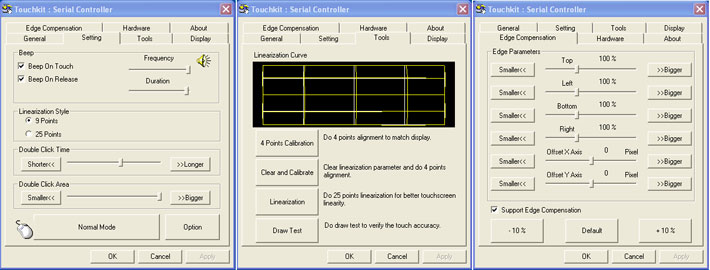
Wireless and expansion
Integrated wireless communication is standard in almost all current computers, and the Winmate I880 is no different. It comes with an internal PCI-Express QCOM 802.11b/g module. The WiFi module can either be controlled by the standard Windows Zero Configuration utility or via a substantially more comprehensive and well-documented configuration utility from Ralink, RaConfig.
 RaConfig is a tool for advanced users who want to have precise control over their wireless setup. The statistics section of RaConfig can be used to detect network problems. A special WMM panel controls wireless multimedia. Another one handles WPS (Wi-Fi Protected Setup) configurations. RaConfig is a tool for advanced users who want to have precise control over their wireless setup. The statistics section of RaConfig can be used to detect network problems. A special WMM panel controls wireless multimedia. Another one handles WPS (Wi-Fi Protected Setup) configurations.
If you want to stay with the standard Microsoft setup, RaConfig can still provide a variety of monitoring functions without interfering with the Windows Zero configuration or profiles.
Bluetooth Version 2.0 with EDR (Enhanced Data Rate) is available as an internal USB module, as is optional PCI Express Card-based GSM/GPRS/EDGE CDMA/UMTS and GPS. Our review unit did not have the WAN function and so we could not test it. Whatever options you specify will be supported with the required internal antennas.
In terms of expansion cards, the unit has a single PCI Express Card slot that is externally accessible. The SD Card slot that's available in some of the smaller Winmate tablets is missing.
Ruggedness
Winmate, as a company, has what one might call a holistic approach to rugged computing. In an overview page on their website they explain what ruggedness means to them, and what standards their rugged and semi-rugged devices must fulfill. They also explain things in simple language as opposed to the often confusing tech specs found in product literature.
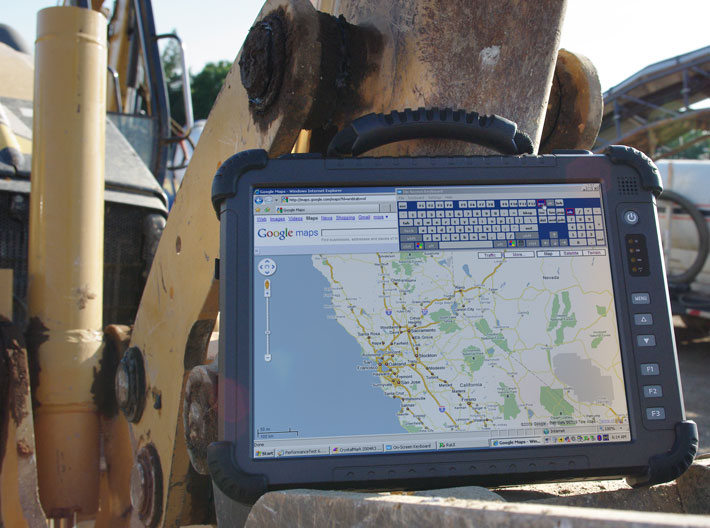
It's really all common sense. For example, "drop" means an operator drops a computer while holding it in the crook of his arm while collecting data. Shock means the often unpredictable forces a computer is subjected to when mounted in a vehicle, or when the vehicle is in an accident or collision. Vibration means the low level vibration from a motor when a computer is mounted in a vehicle, plus the impact of bumps, pot holes and so on. Temperature range means that a computer left in a car in the sun must start when the operator returns. It also must be able to handle whatever an operator might encounter on the job. Spills and dust means the machine must be reasonably protected against dust, rain or spills in typical working situations.
Winmate also has a matrix that shows the types of testing different types of rugged and semi-rugged equipment must pass. In this matrix, "fully rugged" equipment must be sealed to an IP65 level; shock, drop and vibration is tested according to the procedures and levels specified in MIL-STD-810F; operating temperature must be -4 to 140 degrees Fahrenheit; and housings must be aluminum-magnesium alloy.
The well-protected I880 is marked as a fully rugged machine. The spec sheet lists shock and vibration testing according to MIL-STD-810F 516.5 (4-foot drop) and MIL-STD-810F 514.5, respectively, but qualifies that as only pertaining to SD or industrial Compact Flash equipped units. The operating temperature range is a very wide -4 to 140 degrees Fahrenheit. Winmate states that it commissions 3rd party testing for shock and vibration, and is able to perform MIL-STD-810F thermal and drop testing inhouse in their own qualified lab.
Different models
Winmate prides itself in making available a variety of versions and models in a certain product category. Winmate further differentiates between VIA and Intel-based models.
The I680 series is based on the Celeron M processor and comes with various display sizes (8.4, 10.4, 12.1 inches), resolutions (800 x 600, 1024 x 768), and brightnesses (170 to 450 nits).
The V280 series, which we also reviewed in detail, is available both in an R10 (10-inch screen) and an R12 (12-inch screen) version. Each model is available either with the 1.2GHz version of the VIA C7-M processor or the 1.6MHz version. Both 10.4 and 12.1-inch models are available with SVGA (800 x 600 pixel) resolution displays, or with XGA (1024 x 768 pixel) resolution. Some models are also available with extra bright backlights.
The Atom N270-powered IA80 comes with either the 8.4, 10.4, or 12.1-inch display, SVGA or XGA resolution, and brightnesses between 170 and 450 nits, depending on the display.
The Atom Z530-powered I980, comes with either the 8.4, 10.4, or 12.1-inch display, SVGA or XGA resolution, and brightnesses between 170 and 450 nits, depending on the display.
The I880 series, the subject of this review, uses a 1.06 MHz Core 2 Duo processor and is available with the 10.4 and 12.1 inch displays, 800 x 600 and 1024 x 768), and brightnesses (170 to 450 nits).
Note that for all versions of Winmate's Tablet PC, the 10.4 and 12.1-inch models have the same overall dimensions whereas the 8.4-inch model is more compact.
Bottom line
Winmate's line of rugged Tablet PCs includes a variety of screen sizes, display technologies, and processor architectures. All share sturdy part or full magnesium-aluminum housings and a no-nonsense approach to building computers for use in tough environmental settings. The I880 Series is built on an ultra low voltage Intel Core 2 Duo processor and thus seeks to provide the computing power and versatility of a full dual core processor without giving up much battery life.
The Core 2 Duo I880 Series is available with either a 10.4 or a 12.1-inch screen, both in a 12.6 x 9.5 x 2.2 inch body, including protective bumpers. Our 12.1-inch test I880 weighed 5.8 pounds. 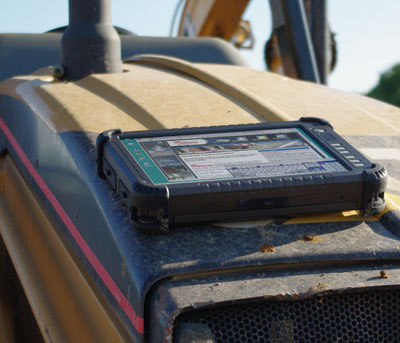 The case — aluminum-magnesium alloy bottom, plastic top — is very solid and well executed, and there is extra protection in the form of large rubber bumpers. The I880 is sealed to IP54 specifications. The case — aluminum-magnesium alloy bottom, plastic top — is very solid and well executed, and there is extra protection in the form of large rubber bumpers. The I880 is sealed to IP54 specifications.
Winmate has a history of offering various processor architectures and options. The rugged Tablet PC platform is available with low power VIA and Intel Celeron M chips, and now also with the very popular Intel Atom processors. The Core 2 Duo U7500 CPU in the Rugged Tablet I880 is running at a clock speed of 1.06GHz. This chip, in conjunction with its complementing Intel 945 GME and ICH7 chipset, is a power-efficient solution for applications that do require advanced computing performance. Despite the powerful processor, the I880 does not need a fan (it does heat up, though).
The 12.1-inch version of the Winmate Tablet PC is perfect for applications that require more screen real estate and benefit from the higher XGA (1024 x 768 pixel) resolution. The display in our review unit was well readable outdoors and its antiglare properties eliminated almost all reflections. The resistive touch screen is very responsive and highly configurable. An electromagnetic digitizer is not available.
Onboard connectivity consists of three USB 2.0 ports, RS232 serial, audio in and out, RJ45 LAN, and a docking connector. An optional multi-function dock has four more USB ports, analog video, LAN and a charger for a second battery. The I880 has an externally accessible PCI Express 34 slot that can be used for expansion or for GPS or wide area wireless radio communication options. All ports are sealed with attached protective rubber plugs.
Our review unit ran Windows XP Embedded on a 80GB 5400rpm SATA disk and 512MB of RAM. We were surprised to see how quick and responsive XP Embedded ran on just 512MB.
While facing well-established competition in the industrial tablet market, the Intel Core 2 Duo-based Winmate I880 offers a clean and highly configurable rugged tablet computing platform that is well suited for a wide variety of challenging jobs in field service, law enforcement, fire/emergency, transportation & distribution, construction, utility and energy, warehousing, patient information, and retail.
-- Conrad H. Blickenstorfer
Winmate Rugged Tablet PC I880 Specs:
| Type |
Rugged pen tablet
|
| Processor |
1.06GHz Core 2 Duo U7500 |
| Display Chipset |
Intel 945 GME + ICH7 |
| OS |
Windows XP Embedded
|
| Memory |
512MB to 2048MB DDR2 400MHz via one SODIMM slot |
| Display |
12.1" XGA (1024 x 768) TFT with 200 or 450 nits LED backlight (10.4-inch display version has 400 nits SVGA or 170 nits XGA display) |
| Digitizer |
4-wire resistive touch screen |
| Keyboard |
Optional external USB keyboard |
| Storage |
80GB 5400rpm 2.5-inch Fujitsu MHZ2080BH SATA 300 hard disk; industrial CF Flash also available
|
| Expansion slots |
1 PCI Express 34 slot
|
| Housing |
Aluminum-magnesium alloy back, ABS plastic front, with protective rubber bumpers |
| Size |
12.6 x 9.5 x 2.2 (including rubber bumpers) |
| Weight |
5.8 lbs. as tested (with battery, bumpers and handle)
|
| Operating temperature |
-4 to 140 degrees Fahrenheit |
| Ingress protection |
IP54 whole unit |
| Drop |
MIL-STD-810F M516.5 4 feet to concrete (with SSD or CF Flash) |
| Vibration |
MIL-STD-810F 514.5 (with SSD or CF Flash) |
| Power |
Rechargeable Li-Ion, 11.1V, 4,800mAH 53.3 WHr (11.1V, 5,600mAH announced) |
| Interface |
3 USB 2.0, serial, gigabit RJ45, audio in/out, docking (LAN, VGA, 4 USB) |
| Wireless options |
802.11b/g, Bluetooth; optional PCI Express Card-based GSM/GPRS/EDGE CDMA/UMTS, optional GPS, optional integrated 1D/2D barcode scanner
|
| Price |
depends on configuration |
| Contact |
winmate.com.tw
Sales1@winmate.com.tw |
(copyright 2009 RuggedPCReview.com)
|



